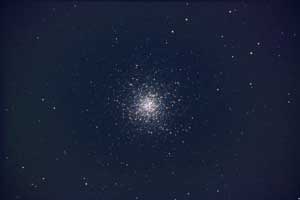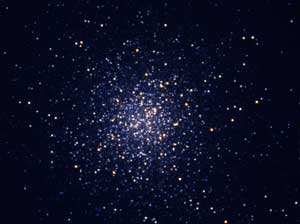Images taken by Roland Christen to test Astro-Physics Equipment
and Recommended Products and Techniques
(along with 12" f/12.5 Mak-Cas and 3600GTO "El Capitan" German Equatorial Mount)
|
Click HERE or on image for Full Size Screen from Maxim DL showing FWHM data on test image. |
From Sept. 19, 2008 post to AP-GTO Group (slightly edited) Roland and Howard set up a 3600 mount last night (9-18-08) from scratch, polar aligned it and began imaging by 8pm, just after evening twilight. "We were able to do unguided imaging with a focal length of 3810 mm (12" F/12.5 Mak-Cass), achieving FWHM stars of 1.8 arc seconds on M13. The seeing wasn't the greatest and there were thin high clouds, but the real achievement was to do the polar alignment without using a polar scope or drift alignment, and still be able to get the alignment dead nuts accurate for unguided imaging. |
|
| Now that the Altitude was set with Vega conveniently almost straight up, we entered Arcturus, which is presently deep in the west. The star was off about 1 degree in the N-S direction. We adjusted the Azimuth axis until it was right on the crosshair and slewed back to Vega. As expected, Vega was still dead nuts on the crosshair because of its location straight up (turning the azimuth axis simply rotated it but did not displace it on the crosshairs which makes this alignment a bit easier and faster). Now that we had two stars in the E-W direction on the crosshairs, plus I had the finder orthogonal, we slewed to Deneb and Altair on the other side of the Meridian. Both of those stars were almost exactly on the crosshairs also. Finally we slewed to Polaris as the acid test. It was also very close, not quite on the crosshairs, but probably off only a tiny fraction in the N-S direction, so I decided to let it be. The best polar alignment is actually to be on the refracted pole, and this alignment was close to that point. The entire polar alignment routine took maybe 20 - 30 minutes, at a leisurely pace. |
||
|
Click HERE or on image for Full Size Cropped Image from the Full-Frame, Full-Resolution, Stacked Image |
Our first target, M13 was acquired and after doing careful focusing we were getting around 1.5 arc sec FWHM, and as anyone who does imaging knows, this is very good resolution. The production worm on this 3600GTO mount is made with a new gear cutting method that we developed here after much testing, and it produced a raw periodic error of under 2 arc seconds without PEM in a 5 minute worm cycle. With this low an error, together with the above polar alignment we were able to do 30 second unguided imaging at 3810mm focal length on M13 and get no drift in either axis, with nice round stars. Average star sizes were 1.8 arc sec FWHM at the beginning of the imaging session. As it got darker and M13 began to drop down in the west, the air began to get more unsteady and the seeing deteriorated to around 2 arc sec FWHM. (we have posted these images of M13 of 6.7 minutes total exposure LRGB, unguided taken with 12" F/12.5 Mak Cass at prime focus). I would encourage all of you imagers to try this method, especially now that Vega is so well placed, and can be seen just after sunset. In fact, if you can pre-align your axes using my famous Park1 - Park 2 method, you will be able to pick up these stars while the sun is still up, and finish polar alignment at sunset. This method of alignment is powerful, almost foolproof, and very accurate. It beats the drift alignment in terms of speed, and does not require a computer or CCD camera to work. You just need a crosshair finder, and it has the added bonus of getting your finder aligned orthogonally. Rolando |
|


